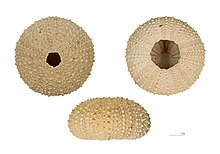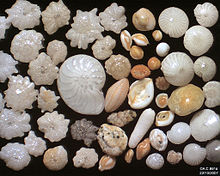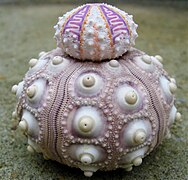Test (biology)
This article needs additional citations for verification. (July 2016) |

| Part of a series related to |
| Biomineralization |
|---|
 |
In biology, a test is the hard
Etymology
The anatomical term "test" derives from the Latin testa (which means a rounded bowl, amphora or bottle).
Structure
The test is a skeletal structure, made of hard material such as
In sea urchins

The test of sea urchins is made of calcium carbonate, strengthened by a framework of calcite monocrystals, in a characteristic "stereomic" structure. These two ingredients provide sea urchins with a great solidity and a moderate weight, as well as the capacity to regenerate the mesh from the cuticle. According to a 2012 study,[1] the skeletal structures of sea urchins consist of 92% of "bricks" of calcite monocrystals (conferring solidity and hardness) and 8% of a "mortar" of amorphous lime (allowing flexibility and lightness). This lime is constituted itself of 99.9% of calcium carbonate, with 0.1% structural proteins, which make sea urchins animals with an extremely mineralized skeleton (which also explains their excellent conservation as fossils).[1]
In foraminiferans

The test of
In ascidians
In
Other terms
On a strictly scientific point of view, the term "test" should be restricted to the hard shell protecting sea urchins and foraminiferans. For sessile echinoderms (like
-
Sea urchin tests (Coelopleurus exquisitus on a Phyllacanthus imperialis).
-
Test of a purple sea urchin.
-
Test of an irregular sea urchin (Echinocardium).
-
AdriaticSea.
References
- ^ PMID 22343283.
- ISBN 978-3-319-14573-0, retrieved 2020-09-12
- ^ Endean, The Test of the Ascidian, Phallusia mammillata, Quarterly Journal of Microscopical Science, Vol. 102, part 1, pp. 107-117, 1961.




